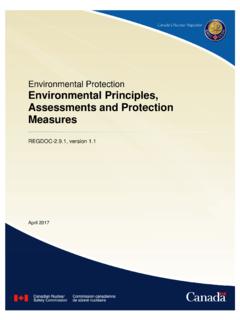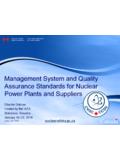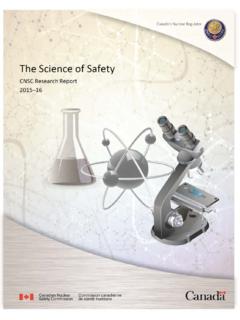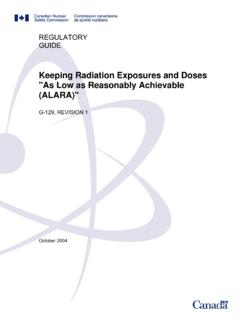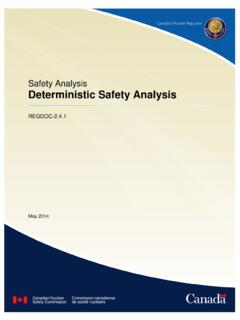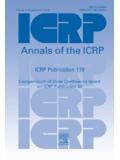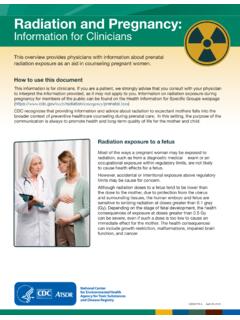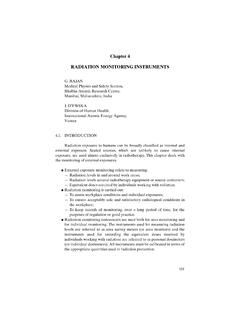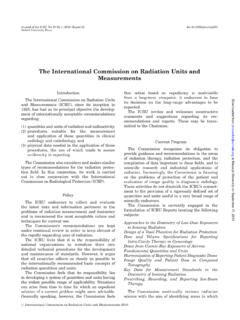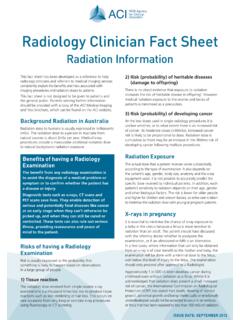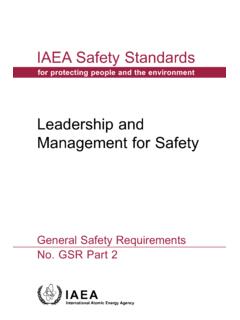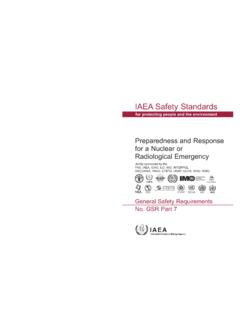Transcription of Radionuclide Information Booklet - Canadian Nuclear …
1 Radionuclide Information Booklet February 2017 Title of Document Radionuclide Information Booklet Canadian Nuclear Safety commission (CNSC) 2017 PWGSC catalogue number CC172-162/2017E-PDF ISBN 978-0-660-06034-7 Extracts from this document may be reproduced for individual use without permission provided the source is fully acknowledged. However, reproduction in whole or in part for purposes of resale or redistribution requires prior written permission from the Canadian Nuclear Safety commission . galement publi en fran ais sous le titre : Livret d Information sur les radionucl ides Document availability This document can be viewed on the CNSC website. To request a copy of the document in English or French, please contact: Canadian Nuclear Safety commission 280 Slater Street Box 1046, Station B Ottawa, Ontario K1P 5S9 CANADA Tel.
2 : 613-995-5894 or 1-800-668-5284 (in Canada only) Facsimile: 613-995-5086 Email: Website: Facebook: YouTube: Twitter: @CNSC_CCSN Publishing history February 2017 Version February 2017 Radionuclide Information Booklet Table of Contents Radionuclide Information Booklet .. 1 H-3 .. 5 C-14 .. 6 F-18 .. 7 P-32 .. 8 S-35 .. 9 Ca-45 .. 10 Sc-46 .. 11 Cr-51 .. 11 Fe-55 .. 13 Co-57 .. 14 Co-58 .. 15 Co-60 .. 16 Ga-67 .. 17 Ge-68/Ga-68 .. 18 Ga-68 .. 19 Se-75 .. 20 Sr-90/Y-90 .. 21 Y-90 .. 22 Mo-99/Tc-99m .. 23 Tc-99m .. 24 Cd-109 .. 25 In-111 .. 26 I-123 .. 27 I-125 .. 28 I-131 .. 29 Sb-124 .. 30 Cs-137/Ba-137m .. 31 Ir-192 .. 32 Tl-201 .. 33 Am-241 34 Appendix A: Concrete TVL validation .. 35 Appendix B: Emergency Procedures .. 36 References .. 37 1 Radionuclide Information Booklet The purpose of the Radionuclide Information Booklet is to provide practical Information to aid radiation protection specialists at Canadian Nuclear Safety commission (CNSC) licensed facilities.
3 The Radionuclide Information Booklet contains Information pages for radionuclides commonly used in the medical, research, and industrial sectors. These Information pages may be posted at CNSC-licensed facilities as a convenient way to quickly find Information . The Information pages within the Radionuclide Information Booklet are organized by atomic number (Z). However, it is important to ensure the most recent Information pages are being used, and it is ultimately the user s responsibility to use the Information appropriately. Radionuclides with long decay chains including multiple short-lived progeny are not included in the Radionuclide Information Booklet as their Information is too complex to be captured within this format. The following sections describe each of the six parts of the Radionuclide Information Booklet pages. It is important to also consult your CNSC licence, the Nuclear Substances and Radiation Devices Regulations, and the Radiation protection Regulations for CNSC s regulatory requirements as the Radionuclide Information Booklet does not replace them.
4 Part 1 Radionuclide identification This section includes the chemical symbol, common name, atomic weight, and atomic number of the specified Radionuclide . Part 2 Radiation characteristics This section includes the physical half-life and (if applicable) the radioactive progeny. The source of this Information is the library (released December 22, 2011) accessed through the Nucleonica Nuclear Science Portal [1]. The energies of the three most abundant emissions and the energies of the three most energetic emissions are provided with their emission probabilities in brackets. The source for this Information is the Joint Evaluated Fission and Fusion File (JEFF) nuclide library accessed through the Nucleonica Nuclear Science Portal [2]. Only energies above 10 kiloelectron volts (keV) or emission probabilities greater than were included with the exception of Fe-55, which has no energies above 10 keV.
5 The energies provided for electron, beta, and positron radiation are the maximum energies. Also included are: (1) First and second half value layers (HVL) and the tenth value layers (TVL) for shielding photons using lead, steel and concrete. These broad beam HVL and TVL values were obtained using Nucleonica s Dosimetry & Shielding++ application [3]. The application uses NIST mass attenuation coefficient tables [4] in conjunction with build-up factors from In the case of concrete, Nucleonica uses ordinary concrete ( g/cm3) from NIST s mass attenuation coefficient table for mixtures and compounds [5]. For validation, select TVL values were also compared against other references (see appendix A). Below are three scenarios which provide different equations for calculating attenuated dose rate using HVLs and TVLs. 2 Scenario 1: If the thickness of shielding is less than one first HVL, the dose rate can be estimated using the equation below: R = (Г x A x 2 t/HVL1) / d2 Scenario 2: If the thickness of shielding is more than one first HVL but less than one first TVL, the dose rate can be estimated using the equation below: R = (Г x A x x 2 -[t-HVL1]/HVL2) / d2 Scenario 3: If the thickness of shielding is greater than one first TVL, the dose rate can be estimated using the equation below: R = (Г x A x 0,1 x 10 -[t-TVL1]/TVL2) / d2 Where.
6 R is the dose rate ( Sv/h) Г is the gamma ray constant for the source at 1 m ( Sv/h par GBq) A is the activity of Nuclear substance (GBq) d is the distance between the Nuclear substance and the location (m) t is the thickness of shielding material, in the direction of travel,* in any shielding wall between the Nuclear substance and the location (mm) HVL1 is the thickness of shielding material to reduce the unshielded dose rate to one half of the original (mm) HVL2 is the thickness of shielding material to reduce the unshielded dose rate to one half of the original (mm) TVL1 is the thickness of shielding material to reduce the unshielded dose rate to one tenth of the original (mm) TVL2 is the thickness of shielding material, in addition to the first TVL, to reduce the dose rate by another one tenth (mm) * Note: If the radiation is penetrating a shielding wall at an oblique angle, the actual thickness of the shielding will be greater than the thickness of the wall.
7 To calculate the attenuated dose rate using Microsoft Excel 2010, the following syntax can be used (where X is the shielding thickness and DR is the unshielded dose rate): =DR*IF(X>=TVL1, *10^(-(X-TVL1)/TVL2), IF(X>=HVL1, *2^(-(X-HVL1)/HVL2), IF(X<HVL1, 2^(-X/HVL1)))). (2) Practical ranges in glass and plastic for electrons and beta radiation. These were obtained from the Radionuclide and Radiation protection Data Handbook 2002 (2nd Edition) [6]. When energetic electrons and beta radiation interact in high Z material ( , lead), electromagnetic radiation called bremsstrahlung is produced. Therefore, high Z materials such as lead may not be appropriate shielding materials for energetic electrons and beta radiation and low Z material should be used first. For low-energy electron or beta emitters such as tritium and carbon-14, bremsstrahlung production is not significant.
8 3 Part 3 Dose rate constants and coefficients External dose In this section, dose coefficients are provided for estimating skin dose from direct contamination and whole body effective dose from external exposure to radiation sources. Unless otherwise indicated, the dose rate from skin contamination is from international Atomic Energy Agency (IAEA)-TECDOC-1162 Generic procedures for assessment and response during a radiological emergency [7]. The gamma ray dose rate at one meter assumes a point source and anterior-posterior geometry. These values were calculated based on the international commission on radiological protection s (ICRP) fluence to effective dose conversion coefficients (linearly interpolated when necessary) provided in ICRP Publication 116 [8] and the photon energies and probabilities obtained from the JEFF nuclide library [2].
9 All photon emissions above 15 keV with a probability above were considered in the calculation. To be conservative, attenuation and build-up in air was not incorporated in the calculation. Internal dose This section includes the ICRP internal dose coefficients for workers, which may be used to estimate internal dose from inhalation and ingestion of the Radionuclide of interest. Unless otherwise stated, these dose coefficients were obtained from ICRP Publication 68 [9]. In the case of inhalation, the coefficients listed are for a particle size (activity aerodynamic diameter, AMAD) of 5 m. Some radionuclides have different dose coefficients for different solubility types which depend on the compound. This Booklet includes the most conservative dose coefficients. Part 4 Clearance and exemption This section summarizes CNSC exemption quantities in becquerel per gram (Bq/g) and Bq, unconditional clearance levels in Bq/g, and nuclide classification.
10 The surface contamination free-release criteria are based on the values found in table 1 of the American National Standards Institute (ANSI) standard [10]. When the Radionuclide of interest is present in table 1 of the ANSI standard, the value is given as published in the standard. When the Radionuclide is not present, the method described in annex A of the ANSI standard was used to ascertain the group (1, 2, 3, 4 or 5) to which the Radionuclide of interest should be attributed, and the corresponding surface contamination free-release value was assigned. This value includes both fixed and removable contamination and applies to the free release ( , municipal landfill, recycling) of surface contaminated objects, as opposed to the removable contamination criteria associated with the nuclide class (A,B,C) which relates to the decommissioning of rooms within a licensed facility.
